FAQ (frequently asked questions)
What distinguishes a paediatric dentist from a normal dentist?
Our team is specially trained to treat children and also has experience in dealing with anxious children and those who are reluctant to undergo treatment. Our premises are exclusively designed for young patients (small dentist's chair, play corner, low reception desk, recovery rooms with cots, etc.), the atmosphere is relaxed and cheerful, and we also "hide" frightening objects.
The treatment methods are also different from those used for adult patients: With lots of love, funny stories, hand puppets and magic wands, we create an anxiety-free, good mood and distract the children from the actual treatment with exciting cartoons, word games and hypnosis techniques. In addition, we have the option of treating with nitrous oxide, sedation or under anaesthesia, accompanied by experienced paediatric anaesthetists.
At what age should my child visit the dentist for the first time?
We recommend a visit from the first milk tooth onwards. The first appointment is mainly to educate the parents. They receive information and recommendations on nutrition, dental care, dummies, bottles, etc. so that they can optimally support their child's oral health from the very beginning. Any problems that may arise are thus recognised in good time and can be treated more easily. Another advantage: the children can already build up trust at the preventive care appointments and do not only get to know us when they have their first "hole".
Why aren't broken milk teeth simply extracted?
Healthy milk teeth are not only important for chewing, speaking and confident laughing! They are also a prerequisite for healthy second teeth. Until the permanent teeth erupt, the milk teeth serve as a placeholder. Premature loss can lead to a considerable lack of space in the dentition. Only (expensive!) braces can then help to create enough space for the permanent teeth. In addition, decay in milk teeth can cause the child pain and inflammation. There is also the danger that the caries bacteria of diseased milk teeth will infect the permanent teeth that have already broken through. If a baby tooth is already irreparable, it still has to be removed. As a replacement, we make an artificial space maintainer that can be worn until the new tooth erupts.
Useful knowledge about the change of your child's teeth
Useful knowledge about the changing of your child's teeth, which takes place in two phases:
1st phase (approx. from 5-8 years of age)
- The 1st tooth change begins around the 6th year of life
- The four upper and four lower milk incisors begin to wiggle and fall out
- The first permanent molar tooth erupts
2nd phase (approx. from the 9th to the 13th year of life)
- The 2nd tooth change begins around the 10th year of life
- The milk canines and milk cheek teeth begin to wobble and fall out
- The second permanent cheek tooth erupts
The ages given are guidelines that are influenced by gender and individual growth. The change of teeth often begins earlier in girls than in boys. Deviations of up to 1.5 years can be observed.
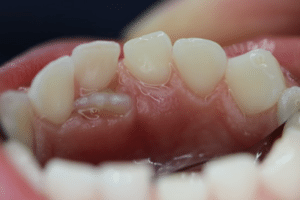
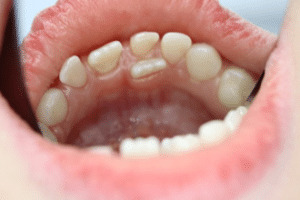
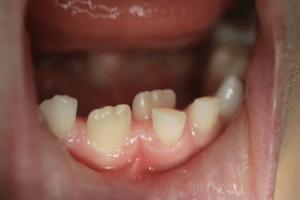
Sometimes it happens that the milk tooth does not wiggle yet, but the permanent tooth can already be seen in front of or behind it. This condition is often called a "shark tooth". Since this is usually a temporary problem, we like to give the loose teeth a grace period of several months. The children should and are allowed to wiggle their loose milk teeth. Even if the new tooth is further back, you as parents need not worry, because the natural pressure of the tongue and lip muscles usually pushes the tooth back into its intended position. However, if the tooth still hasn't come loose after this waiting period or if it is an upper incisor, we as a paediatric dental team would intervene and remove the baby tooth with the help of a local anaesthetic and a "magic trick".
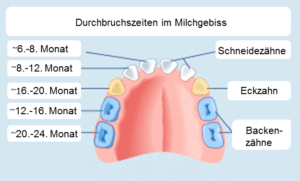
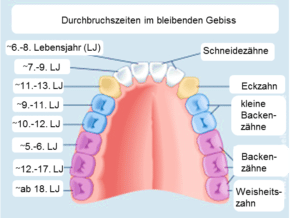
When should children start brushing their teeth and what should they pay attention to?
Dental care should start as soon as the first milk tooth has erupted. In the beginning, evening cleaning with a soft cloth or cotton swab is sufficient. Later, children's toothbrushes should be used. If your child is given fluoride tablets, it is better to use only water or non-fluoridated toothpaste. We will be happy to advise you on this. From the age of 2, milk teeth should be brushed with a pea-sized amount of fluoridated children's toothpaste in the morning and evening. Let your child learn to brush his or her own teeth, but be sure to brush them once a day before or after the third grade! From the age of 6 or when the first permanent teeth erupt, your child should use toothpaste with a higher amount of fluoride (normal adult toothpaste or junior toothpaste). Some children don't like having their teeth brushed. Try games, singing to them and distractions. If necessary, hold your child. Don't worry, you won't traumatise your child by doing this, because neither brushing their teeth nor gently holding them hurts. On the contrary, if you give your child the will, brushing teeth will become a stressful situation every day.
Is sucking on a pacifier, thumb or finger harmful?
If a child sucks particularly frequently over a long period of time, whether on fingers or pacifiers, tooth misalignments can develop. Most often, the socalled "open bite" develops, in which the front incisors no longer come together when biting down. This can cause problems with "biting off", and in some cases the child also starts to lisp. Children should not use the pacifier longer than until the age of two, usually they give it up willingly at this age. Many children do not get used to sucking their thumb or fingers as easily. Our team will advise you what parents can do to prevent sucking.
What do I have to bear in mind when eating a diet that is gentle on the teeth?
Caries only develops when the pathogens can attack the teeth often enough and there is no time for regeneration. If a child sucks on a bottle of juice, juice spritzer or children's tea all day long or even at night, the milk teeth are permanently confronted with bacteria - a high caries risk is the result. It is therefore much more important than a sugar-free diet to limit sweet and acidic drinks. This also includes juices declared as "sugar-free", as they contain a large amount of fructose! You should only offer your child sugary or acidic drinks at mealtimes (maximum 2 times a day). The rest of the day, give your child still mineral water to drink. Unfortunately, not all children who once got to know sweet drinks like water. In order to make water palatable to the children again, you sometimes have to resort to a few tricks. We are happy to help you.
What does the treatment cost?
Statutory health insurance typically covers the costs of simple "standard treatment." This includes regular (2-3 times a year) checkups, including X-rays (if necessary), cement fillings, and the cost of local anesthesia. The insurance also covers the costs of two individual preventative appointments per year, but only starting at the age of 6. Therefore, there is always a "free" alternative, although this is not necessarily the best. Unfortunately, small co-payments are required to provide optimal care for your child; these must be discussed individually based on treatment needs and findings.
Please contact your health insurance provider for information about the benefits of private health insurance.
MIH - What is it?
Molar incisor hypomineralization (MIH), also known as "chalk teeth", is now considered a widespread disease in Germany. Almost every 3rd child has more or less pronounced hypomineralization. In most cases, the large molars and incisors in the permanent dentition are affected. However, the structural disorder can also occur in the deciduous dentition. The cause of the structural change of the tooth structure is still largely unexplained. Therefore, the disease cannot be cured, but only treated symptomatically with fissure sealants, fillings or crowns. There are different degrees of severity of the disease. Slightly affected teeth have only small white or yellow spots, other teeth lack the entire chewing surface. The teeth are often very sensitive to pain and even brushing them hurts. But this is very important, because the teeth are very susceptible to caries. Regular check-ups and preventive measures at the dentist are indispensable. How and with which materials we treat the teeth, we discuss individually. It is often difficult to treat the soft, porous enamel because local anaesthesia has only limited effect on MIH teeth. Whether sedation with nitrous oxide or intubation anaesthesia is appropriate for optimal treatment depends on the child's willingness to cooperate and the severity of the condition.
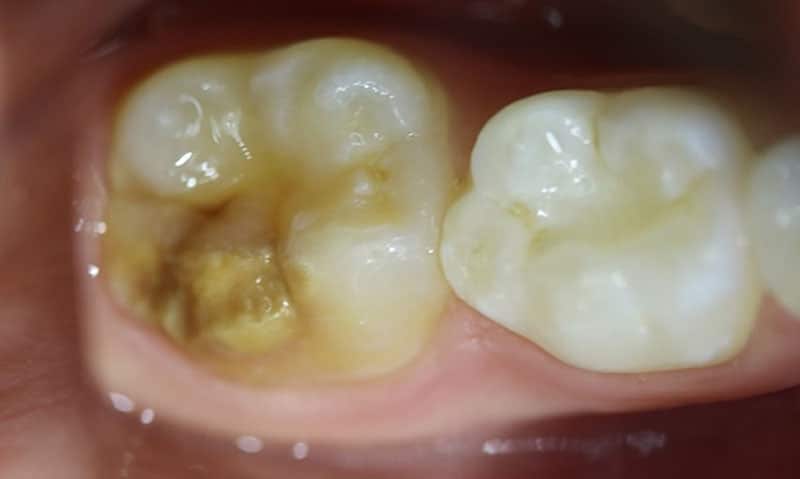
Fig .: MIH on the molar

